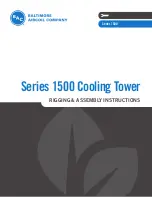
14
Fig. 17 —
Thru-the-Base Fitting Assembly (Shown in
Shipping Position)
Fig. 18 —
Thru-Base Connection Fittings
1. Remove the “L” bracket assembly from the unit.
2. Remove connector plate assembly from the “L” bracket
and discard the “L” bracket, but retain the washer head
screws and the gasket (located between the “L” bracket
and the connector plate assembly).
NOTE: Take care not to damage the gasket, as it is reused in the
following step.
3. Place the gasket over the embossed area in the basepan,
aligning the holes in the gasket to the holes in the basepan.
See Fig. 18.
4. Install the connector plate assembly to the basepan using 8
of the washer head screws.
The thru-base gas connector has male and female threads. The
male threads protrude above the basepan of the unit; the female
threads protrude below the basepan.
Check tightness of connector lock nuts before connecting gas
piping.
Install a
1
/
2
-in. NPT street elbow on the thru-base gas fitting.
Attach a
1
/
2
-in. pipe nipple with minimum length of 16
-
in.
(406 mm) (field-supplied) to the street elbow and extend it
through the access panel at the gas support bracket. See
Fig. 19.
Fig. 19 —
Gas Line Piping for 3 to 5 Ton Units Only
Other hardware required to complete the installation of the gas
supply line includes a manual shutoff valve, a sediment trap
(drip leg) and a ground-joint union. A pressure regulator valve
may also be required (to convert gas pressure from pounds to
inches of pressure). The manual shutoff valve must be located
within 6 ft (1.83 m) of the unit. The union, located in the final
leg entering the unit, must be located at least 9-in. (230 mm)
away from the access panel to permit the panel to be removed
for service. If a regulator valve is installed, it must be located a
minimum of 4 ft (1220 mm) away from the unit’s flue outlet.
Some municipal codes require that the manual shutoff valve be
located upstream of the sediment trap. See Fig. 20 and 21 for
typical piping arrangements for gas piping that has been routed
through the sidewall of the curb. See Fig. 22 for typical piping
arrangement when thru-base is used. Ensure that all piping
does not block access to the unit’s main control box or limit the
required working space in front of the control box.
Fig. 20 —
Gas Piping, Typical Curb Sidewall Piping
(Example 1)
LOW VOLTAGE
CONDUIT
CONNECTOR
HIGH VOLTAGE
CONDUIT
CONNECTOR
BRASS FITTING FOR
3 TO 6 TON UNITS
AUXILIARY
POWER
SUPPLY
(OPTIONAL)
BRASS FITTING
FOR GAS PIPING
SUPPORT
BRACKET
EMBOSSMENT
9” (229mm) MIN
UNION
SHUT OFF
VALVE
DRIP
LEG
THRU-CURB ADAPTER
UNIT BASE RAIL
Содержание WeatherExpert 48JC04
Страница 4: ...4 Fig 2 Unit Dimensional Drawing ...
Страница 5: ...5 Fig 2 Unit Dimensional Drawing cont ...
Страница 6: ...6 Fig 2 Unit Dimensional Drawing cont ...
Страница 24: ...24 Fig 46 48JC 04 06 Control Wiring Diagram ...
Страница 25: ...25 Fig 47 48JC 04 06 Power Wiring Diagram 208 230 460V Unit Shown ...
Страница 26: ...26 Fig 48 48JC 04 06 Power Wiring Diagram 575V Unit Shown ...
Страница 32: ......
Страница 33: ......















































